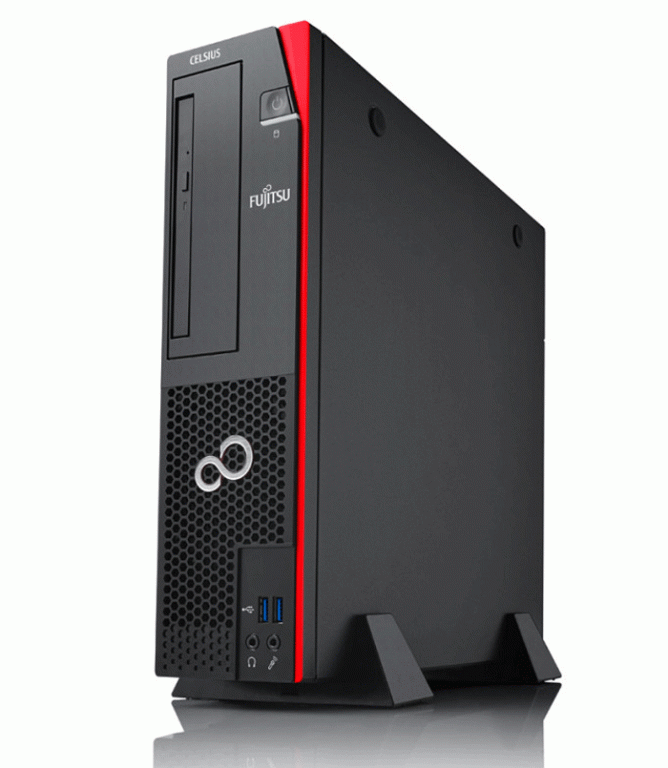Designed and manufactured in Augsburg, Fujitsu has used its German engineering know-how to make a compact workstation with no compromise graphics. By Greg Corke
While most workstation manufacturers already have several generations of Small Form Factor (SFF) workstations under their belts, Fujitsu has only just rolled out its first. But for designers seeking a compact desktop with almost no compromises the Fujitsu Celsius J550 has been worth the wait.
The Celsius J550 stands out for its 3D graphics capabilities. Unlike other machines in its class, it can host a full height graphics card, up to the mid-range Nvidia Quadro K2200 (4GB) or AMD FirePro W5100 (4GB).
This is big news for 3D CAD users as they can now get levels of 3D performance that were previously only available in a tower.
In comparison, SFF workstations from Dell, HP and Lenovo rely on a low profile graphics card, such as the AMD FirePro W2100 or Nvidia Quadro K1200, to fit inside their slimline chassis. For more demanding 3D CAD users, these GPUs are likely be a bit underpowered.
The Celsius J550 manages to squeeze in its full height graphics card by making it sit parallel, rather than perpendicular, to the motherboard. The riser card that makes this possible is a simple, but impressive piece of German engineering. It can be quickly removed from the motherboard making upgrades or repairs easy.
Similar attention has been paid to storage, with a drive cage that hinges through 90 degrees to give easy access to up to four 2.5-inch Solid State Drives (SSDs) or two 3.5-inch Hard Disk Drives (HDDs).
For workflows with high I/O requirements, such as point cloud processing, video editing or simulation, high performance PCIe storage is also on the menu. There is support for up to three M.2 NVMe SSDs (one on the motherboard and two on a PCIe add-in card) and it is even possible to configure two of these tiny drives in a RAID 0 array. Such high speed storage used to be a hallmark of high-end workstations, so this is quite exceptional for a machine of this class.
Despite the high-end storage capabilities, most CAD users will be more than adequately served by one or two drives.
Our test machine’s 512GB 2.5-inch SSD gives ample space for OS, applications and current datasets, but a secondary 1TB or 2TB Hard disk Drive (HDD) would not go amiss if you have a lot of data. Those on a budget may consider dropping down to a 256GB SSD, which will save £120.
Despite packing in the graphics and storage, the Celsius J550 still compares favourably in terms of size. At 332mm (w) x 338mm (d) x 89mm (h) it is only slightly bigger than the Dell Precision Tower 3420 (290mm x 292mm x 93mm) and is actually smaller than both the HP Z240 SFF (338mm x 381mm x 100mm) and Lenovo ThinkStation P310 (338mm x 394.5mm x 102mm).
The chassis is reassuringly solid, weighing close to 9kg. It can sit horizontally or vertically on the desk, with detachable feet giving added stability. There’s no shortage of USB 3.0 ports, with two at the front and six at the rear.
For everyday CAD work, performance is excellent and there is virtually nothing to separate it from the significantly larger HP Z240 Tower (see page 30) although the Z240 Tower does have optional higher end graphics, up to the AMD FirePro W7100 or Nvidia Quadro M4000).
With four cores and a clock speed of 3.6GHz, the Intel Xeon E3-1275 v5 is ideal for performance CAD, though the built-in Intel HD Graphics P530 is somewhat redundant with the add-in AMD FirePro W5100.
Depending on budget, there are over 10 other CPUs to choose from, including a range of quad core Xeon E3-1200 v5 and Intel Core i3, Core i5 and Core i7. Our test machine felt very responsive when working inside Revit and MicroStation Connect, even when working with large models.
With only 8GB DDR4 RAM we did hit the memory limits at times so would definitely recommend an upgrade to 16GB, adding £50 to the cost of the machine. With a maximum capacity of 64GB there is plenty of scope for future upgrades.
The one downside to the Celsius J550 is fan noise. While there was only a gentle hum in day-to-day CAD work, noise became more noticeable when rendering or hammering both CPU and GPU in our graphics benchmarks. It is not loud by any means, but there are certainly quieter machines out there.
Conclusion
Fujitsu may be late to the party with its SFF workstation but it certainly blows the competition out of the water when it comes to 3D graphics. By offering a choice of full height mid-range GPUs inside the Celsius J550, power CAD users can now have it all: the performance of a tower in a chassis less than half the size. For this reason alone Fujitsu’s machine demands close attention.
Added to that, with a huge choice of drives and CPUs, and a well engineered chassis, there is plenty more to like about the Celsius J550. Unless your workflow demands more CPU cores for simulation or rendering, or higher end graphics for design viz, the SFF workstation now presents a truly tempting alternative to the deskspace-hungry tower.
Specifications
■ Intel Xeon E3-1275 v5 (3.6GHz up to 4.0GHz) (Quad Core) processor
■ 8GB (2 x 4GB)DDR4 2,133MHz ECC memory
■ 512GB SSD
■ AMD FirePro W5100 (4GB GDDR5) GPU (15.201 driver)
■ Microsoft Windows 7 Professional 64-bit
■ 332 x 338 x 89mm
■ 3 years bring-In/ onsite service warranty
■ £1,450
If you enjoyed this article, subscribe to AEC Magazine for FREE






